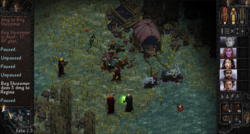Rampant Coyote on Progression in CRPGs
Rampant Coyote on Progression in CRPGs
Editorial - posted by Infinitron on Fri 4 January 2013, 23:41:31
Tags: Jay Barnson; Rampant GamesJay Barnson has put up a blog post in which he describes and reflects upon the various mechanisms of "progression" in CRPGs. Here's an excerpt:
In Jay's opinion, it's most interesting when a game uses a mix of all four progression systems. He notes that since most mainstream games nowadays (with the notable exception of Bethesda titles) favor "harder" progression, indie developers should try to differentiate themselves by going for a "softer" design approach.
RPGs have an inherent bias towards linearity, if only for their story and the fact that characters make (generally) move along a major axis of weak to strong. Even with a threadbare story, the dreaded Foozle or end-goal amulet is always behind some extreme challenges that you can’t just waltz in immediately and take to win the game. You have to progress through the content- be it storyline or dungeon levels – in something resembling a particular order to take a crack at the big finale.
There are four common mechanisms – plus variants – to enforce this orderly progression (or “unlocking of content”, to use more boring modern terminology):
#1 – Discovery-based: You can’t go to a place in the game until you either stumble across it manually via exploration, or perhaps learn about it from an in-game source in the process of a conversation or found map. The only real obstacle in this case is geography (or geography plus events). The advantage of discovery-based progression is that it rewards exploration (in all its forms), and makes the world feel much more open-ended. The disadvantage is that it can be frustrating to try and hunt for an entrance or exit, and that – depending upon how it is set up – it may allow parts of the game to be bypassed.
#2 – Challenge-based: Theoretically the final battle or end goal is achievable fairly early in the game, but the difficulty is such that it is effectively impossible until the player’s character or party has grown enough to overcome the challenges. The biggest advantage of this technique is that it puts the pace of the game – and its difficulty level – in the hands of the player. It also removes what may feel like ‘artificial’ barriers to the endgame. However, it can be very frustrating if the player unknowingly goes to an overly difficult area (perhaps missing easier areas by accident). It can also encourage ‘grinding,’ pretty low-quality entertainment.
#3 – Obstacle-based: A part of the game is blocked by a barrier that cannot be removed by brute force, but rather by a not (strictly) story-driven mechanism, such as finding a magical key, learning a mantra / password, or obtaining a means of travel that allows passage. It does allow the player to progress at their own pace, while forcing them to explore other areas to obtain whatever is needed to clear the obstacle. These can also serve as a reward in and of themselves, as it’s kinda fun when a formerly impassible barrier suddenly ceases to be an obstacle. However, frustration can rise when it is unclear how to overcome the obstacle, or when the obstacle fails to make sense in the logic of the game – for example, when characters can destroy dragons with ease, but a simple wooden door acts as an impenetrable barrier.
#4 – Plot-based: The player is moved around in the world – or parts of the world become available – based more directly by plot progression. This makes it very easy for the developer to control content – for example, not allowing players to go back to a previous area and converse with people after a major event has occurred (thus not requiring tons of additional voiced scripts of dialog that have no direct bearing on the game). It is also easy for players – particularly inexperienced players – as there’s no need to hunt for the “next” place to be. However, it can also feel very constrained and contrived as a player.
I listed these in order of “hardness” – how strictly the game enforces the linearity of progression. In a discovery-based system, if you know where to look for these places, you can go there almost immediately. Challenge-based progression will let you go there if you are very good or very lucky. Obstacle-based progression requires you to do a little hunting around to find what you need to overcome or bypass the obstacle (although in older games like the Ultimas with text-based passwords, you could cheat and obtain the words with out-of-game information). And finally, plot-based progression is the ultimate in heavy-handedness: you just can’t go there until the game gets to a particular stage.
In Jay's opinion, it's most interesting when a game uses a mix of all four progression systems. He notes that since most mainstream games nowadays (with the notable exception of Bethesda titles) favor "harder" progression, indie developers should try to differentiate themselves by going for a "softer" design approach.
There are 36 comments on Rampant Coyote on Progression in CRPGs













